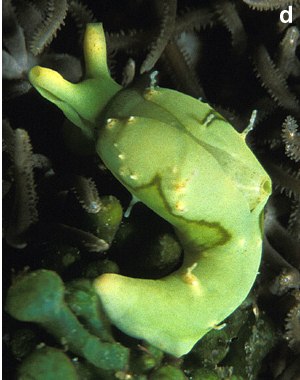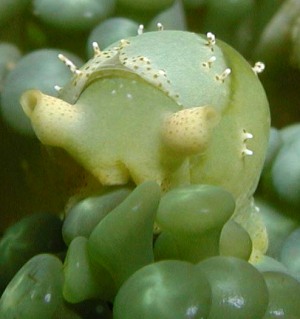
Oxynoe kabirensis
Hamatani, 1980
Order: SACOGLOSSA
Superfamily: OXYNOOIDEA
Family: Oxynoidae
DISTRIBUTION
Known only from Japan
PHOTO
Hachijo Island, Japan. 30mm long, depth: 10m. Photo: Shouichi Kato
Hamatani notes some differences in the shape of the shell, and considers the radular teeth of O. kabirensis to be somewhat wider than the teeth of O. viridis, but the main difference is in the shape and colour of the living animal. The background colour of O. kabirensis varies from a pale yellowish green to a dark green, but whatever the color there is always a darker region at the base of the parapodia which extends up as a triangular peak in the middle of the parapodia. There can also be secondary peaks at the front and back of the parapodia. The edge of this darker patch is lined with an even darker line. There can be some yellowish spots on the parapodia and there are usually a few scattered very elongate retractile papillae. In O. viridis the background colour is uniform, there being no darker green patch on the parapodia, and usually there are scattered blue spots.
Reference:
• Hamatani, I. (1980) On the species of the genus Oxynoe Rafinesque, 1819 from Japan, inclusive of a new species (Opisthobranchia: Ascoglossa). Publications of the Seto Marine Biological Laboratory, 25(5-6): 349-360.
Rudman, W.B., 2002 (April 28) Oxynoe kabirensis Hamatani, 1980. [In] Sea Slug Forum. Australian Museum, Sydney. Available from http://www.seaslugforum.net/find/oxynkabi
Related messages
Oxynoe kabirensis at Hachijo Island
May 11, 2002
From: Nishina Masayoshi


Dear Bill,
Here are some photos of the head of Oxynoe kabiraensis.
Photo by N.Masayoshi at Hachijo Island.
Best Regards,
Nishina Masayoshi
nishina@wips.co.jp
Masayoshi, N., 2002 (May 11) Oxynoe kabirensis at Hachijo Island. [Message in] Sea Slug Forum. Australian Museum, Sydney. Available from http://www.seaslugforum.net/find/6829Thanks Nishina,
Bill Rudman
Colour camouflage in Oxynoe kabirensis
May 11, 2002
From: Nishina Masayoshi


Dear Bill,
To accompany my other images of Oxynoe kabiraensis here is one showing how I think it is camouflaged when living on the Caulerpa on which it feeds. From the dorsal view, you can see that the dark triangle pattern breaks the light green part of the body into two rounded regions wjhich look similar in shape and size to the Caulerpa's 'ramuli'
Photo by N.Masayoshi at Hachijo Island.
Best Regards,
Nishina Masayoshi
nishina@wips.co.jp
Masayoshi, N., 2002 (May 11) Colour camouflage in Oxynoe kabirensis. [Message in] Sea Slug Forum. Australian Museum, Sydney. Available from http://www.seaslugforum.net/find/6915Dear Nishina,
Thanks for this fascinating photo. I have included a close-up of the animal so it is easier to find in the whole photo at the top. It certainly looks as though the animal's colour pattern is to help it hide, much like the southeastern Australian bivalved sacoglossans such as Midorigai australis.
Best wishes,
Bill Rudman
Oxynoe kabirensis from Hachijo Island, Japan
April 29, 2002
From: Shouichi Kato

Dear Bill,
Please see attached 4 pictures. There are 3 animals from Hachijo Island, Japan, that I think are all variations of Oxynoe kabirensis. But as we can find so many variations, there is an opinion these are the variations of Oxynoe viridis.
I would like to know how we can identify these two species and if these three are all the same species. I always very much appreciate your advice.
Picture (a) (a and b found together)
size; 30mm depth; 3m
Picture (b)
size; 25mm depth; 3m
Picture (c) and (d) (same animal)
size; 30mm depth; 10m
Thanks and best regards,
S. Kato
regulus@edit.ne.jp


Dear Shouichi,
These all certainly fit Hamatani's description of Oxynoe kabirensis which fortunately included a description and illustrations of the living animal, and a comparison with Oxyemnoe viridis.
Hamatani notes some differences in the shape of the shell, and considers the radular teeth of O. kabirensis to be somewhat wider than the teeh of O. viridis, but the main difference is in the shape and colour of the living animal. The background colour of O. kabirensis varies from a pale yellowish green to a dark green, but whatever the color there is always a darker region at the base of the parapodia which extends up as a triangular peak in the middle of the parapodia. There can also be secondary peaks at the front and back of the parapodia. The edge of this darker patch is lined with an even darker line. There can be some yellowish spots on the parapodia and there are usually a few scattered very elongate papillae, which are probbaly retractile. In O. viridis the background colour is uniform, there being no darker green patch on the parapodia, and usually ther are scattered blue spots.
• Hamatani, I. (1980) On the species of the genus Oxynoe Rafinesque, 1819 from Japan, inclusive of a new species (Opisthobranchia: Ascoglossa). Publications of the Seto Marine Biological Laboratory, 25(5-6): 349-360.
Thanks very much for these photos, they are an interesting addition to Hamatani's original description.
Best wishes,
Bill Rudman
